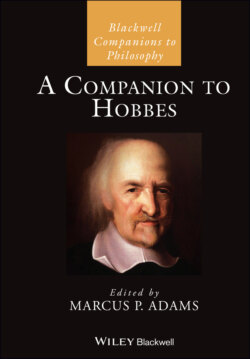Читать книгу A Companion to Hobbes - Группа авторов - Страница 49
3.2.1 Origins of the Dispute
ОглавлениеAlthough the 1655 publication of De corpore can be taken as the controversy’s precipitating event, Hobbes had earned Wallis’s enmity years earlier. The appearance of Leviathan in 1651 made Hobbes a notorious figure in the English “republic of letters,” and Wallis was one of many who was outraged by its materialism, anticlericalism, unorthodoxy, and political theory (Parkin 2010, chapters 2–3). Of particular concern to Wallis (and his Oxford colleague Seth Ward) was Hobbes’s hostility to the universities, which Leviathan portrayed as intellectual backwaters thoroughly beholden to the authority of Aristotle and home to ambitious churchmen and lawyers who sought to undermine sovereign power (Serjeanston 2006). Matters came to a head in 1653 when several Puritan radicals published tracts attacking the English universities and Parliament entertained a bill to disband them.
Ward took up the cause of defending the universities and in 1654 published Vindiciæ Academiarum. Although Hobbes was not Ward’s primary target,13 an Appendix to the work took issue with the status of the universities in Leviathan and challenged Hobbes to make good on his claims to have made great contributions to the sciences, and particularly to geometry. Ward wrote “I have heard that M. Hobbs hath given out, that he hath found the solution of some Problemes, amounting to no lesse than the Quadrature of the Circle” (1654, 57). Clearly aware of the inadequacies in Hobbes’s geometric argumentation he cautioned that
Geometry hath now so much place in the Universities, that when Mr. Hobbs shall have published his Philosophicall and Geometricall Pieces, I assure my selfe, I am able to find a great number in the University, who will understand as much or more of them then he desires they should, indeed too much to keep up in them that Admiration of him which only will content him.
(1654, 58)
In the course of events these taunts proved effective and moved Hobbes to include a circle quadrature in chapter XX of De corpore. The haste with which Hobbes produced this quadrature resulted in his having to revise it at least twice even as De corpore was being printed. In the end, what he had announced as an exact solution to the ancient problem was mournfully downgraded to no more than an approximation that was stated “problematically” rather than demonstratively (Jesseph 1999, 120–5).
Wallis’s Elenchus Geometriæ Hobbianæ appeared only a few months after De corpore and took issue with the entirety of Hobbes’s geometrical enterprise. The evisceration of Hobbes’s circle quadrature was particularly harsh. Having procured an unbound copy of the first impression of De corpore, Wallis traced the sorry history of Hobbes’s hastily revised efforts in a way that portrayed the philosopher from Malmesbury as a mathematical incompetent whose failed demonstrations were the product of incurable ignorance and boundless arrogance. Hobbes was quick to respond, publishing a reply to both Wallis and Ward as Six Lessons to the Professors of the Mathematiques as an appendix to the 1656 Of Body, the English translation of De corpore. The resulting controversy dragged on for the remainder of Hobbes’s life, and it is fair to say that all of his mathematical publications after 1655 are directed against Wallis and written in the shadow of his Elenchus. As he summed up the case in the Preface to Lux:
A certain book of Hobbes’s, De corpore, published early in 1655, provided the occasion for this dispute. The book contains among other things certain geometrical principles differing from the principles accepted today, and also a demonstration (as he termed it) of the equality of a certain right line and the fourth part of the circumference of the circle. This confidence of Hobbes displeased many mathematicians, especially in the famous universities, some of whom had perhaps thought that all the most difficult problems in geometry had been reserved for only them to solve. And so, in order to overturn this demonstration and the whole geometry of Hobbes, John Wallis, public professor of geometry at the university of Oxford published a book entitled Elenchus Geometriae Hobbianae. Εκ τοῦδε ἄρχεται ὁ πόλεμος [From thence arises the war] And this perpetual geometric war has been waged between them without pause. For almost nothing is written by one which is not publicly opposed by the other.
(OL V.93)
There is little to be gained from a close examination of each disputant’s contributions. Indeed, Hobbes himself dismissed Wallis’s works as “puerile, unsophisticated, unlearned, and boorish,” adding “Nor do I judge the replies I have made to your works to be worthy to be read by posterity” (OL IV.522). We can, however, gain some insight into Hobbes’s approach to geometry by examining some details of his method.
